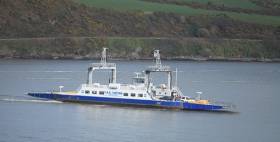Displaying items by tag: Carlingford Ferries
Northern Ferry On Southern Service 'Trials' for New Owners
#BerthingTrials – A pair of car ferries were on the Waterford Estuary link of Passage East-Ballyhack yesterday but only one vessel was actually operating in service, writes Jehan Ashmore.
Foyle Venture (44 vehicle/300 passenger) was carrying out 'berthing trials' for the Passage East Ferry Company service operated by the routine ferry F.B.D. Tintarn (28 vehicle/130 passenger). The south-east service provides commuters a short cut connecting Waterford City and the Wexford region.
The Ulster ferry had previously stopped winter service of the Lough Foyle Ferry Company's Greencastle-Magilligan Point route. Sailings are to resume between Donegal and Derry in Spring 2017.
The established ferry service in Leinster was founded in 1982 by Derek Donnelly who announced his retirement from the business earlier this year. In that timeframe Dunbrody and Edmund D have run the shuttle service until the current ferry FBD Tintarn. This ferry has been in service for a decade having made a debut in December 2006.
As Afloat covered in May the operation was sold to Frazer Ferries, the Limerick based company behind Carlingford Ferries that has proposed a new service in Northern Ireland. As for the Passage East based ferry FBD Tintarn, the prefix refers to FBD Holdings plc which retains a 70% share in the business, arising out of a legacy investment.
Afloat noted Foyle Venture had berthed in Waterford City earlier this week along the Frank Cassin Wharf, the former Bell Liner container terminal.
The ferry has since returned to the same city berth which in recent years was occupied by a passenger freight-ferry that had a wartime role. Afloat will have more on this soon.
Passage East Ferry Company, one of Ireland’s most established domestic ferry services, has been purchased by the owners of Carlingford Ferries, it was announced today.
The decision to sell came as founding shareholder, Derek Donnelly, announced his retirement from the business. FBD Holdings plc holds a 70% share in the business, arising out of a legacy investment.
The sale of Passage East Ferry Company, which traverses the River Suir between Passage East, Co Waterford and Ballyhack, Co Wexford, generated significant interest when it was announced last December on the back of strong financial results and growth projections. Turnover is in the region of €1.6m per annum – up 5% in 2015 – with 30% year-on-year growth in EBITDA.
The purchaser is Limerick-based Frazer Ferries, the company behind the proposed car ferry across the mouth of Carlingford Lough, between Greenore, Co Louth and Greencastle, Co Down.
Commenting on the sale, Paul O’Sullivan of Carlingford Ferries said: “We are very pleased to complete the transaction of Passage East Ferry Company. The ferry is a long-established business and provides a vital service in the region. We look forward to working closely with the team as we embark on this next exciting chapter.”
The sale process was managed by leading business advisory specialists Crowe Horwath.
Managing Partner at Crowe Horwath, Naoise Cosgrove, said: “Passage East Ferry Company boasts a strong trading history, solid revenues, growing EBITDA and clear potential for further growth fuelled by economic and tourism activity in the region, which remains on an upward trajectory.
“It is a smart investment for Carlingford Ferries,” he continued, “who are acquiring a profitable and cash-generative business.”
The sale includes a 28-vehicle ferry and a commercial premises with offices, and stores at Passage East, Co Waterford.
Along with 28 vehicles, the ferry can carry up to130 passengers, connecting Waterford City with the Hook Peninsula in Wexford and operates throughout the year - seven days a week - making an average of 106 sailings per day, increasing to 112 during the summer months.
The five-minute ferry journey is estimated to save 90-minutes journey time for round trip commuters.
Passage East Ferry Company employs 16 full-time staff, all of whom are unaffected by the sale.
A ‘Serious Blow’ As Lough Foyle Ferry Service Ends
#FoyleClosure - The Lough Foyle Ferry Company has sold their ferry reports the Derry Journal. The service ceased with immediate effect has been described as “a serious blow for the area”.
The directors of the company confirmed to the ‘Journal’ the vessel has been sold to Frazer Ferries in Carlingford (as previously reported on Afloat.ie for a new ferry link) and they will not be operating the Greencastle to Magilligan service in the future.
The news is a blow to the future of the service and there have now been calls for a new operator to be put in place as soon as possible, with one councillor stating it would be an “absolute scandal” if it was lost to the area.
It is understood Donegal County Council and Causeway Coast and Glens Borough Council have been informed the company will not be seeking to extend their contract after March 31st, 2016. As the service ended for the winter season on October 4th, it will not be reinstated before then.
The move has led to fears for the future of the service and calls for the two Councils to enter talks immediately to ensure it is not lost.
Donegal County Council told the ‘Journal’ they are aware of the matter and “will be considering options available to us in due course.”
The Foyle Ferry has carried two and a half million passengers since it began in 2002.
For much more the Journal has a report here.
Afloat adds that the ferry sold is the Foyle Venture, built in 1978 and with a capacity for 300 passengers and 44 cars.





























































